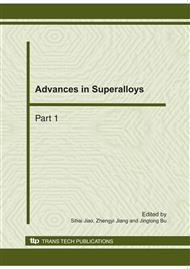p.386
p.390
p.394
p.400
p.408
p.412
p.417
p.424
p.429
Material Fatigue Behavior and its Mechanism Based on MMM Technology
Abstract:
In order to investigate material behavior at the stage of early fatigue damage and critical fatigue fracture, a new nondestructive testing called metal magnetic memory (MMM) technology, has been introduced in this paper. The fatigue experiments are carried out on the PQ1-6 rotary bending fatigue machine. The MMM fatigue characteristics are presented and analyzed. It has been found that Hp(x) is increasing up to the peak value while the fatigue crack is initiating and growing. After that peak, Hp(x) decreases gradually with the fatigue crack deepening and stress releasing. The gradual increasing Hp(x) is the sign of the early fatigue damage and the Hp(x) peak predicts the critical fracture state. The validity of MMM results has been certified by microscopic metallographic examination. Furthermore, the MMM fatigue behavior is deduced theoretically based on the dislocation mechanics and fracture mechanics.
Info:
Periodical:
Pages:
408-411
Citation:
Online since:
October 2010
Authors:
Price:
Сopyright:
© 2011 Trans Tech Publications Ltd. All Rights Reserved
Share:
Citation:


